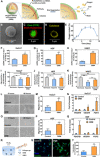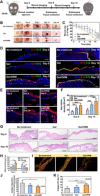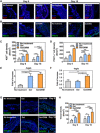Sustained oxygenation accelerates diabetic wound healing by promoting epithelialization and angiogenesis and decreasing inflammation
- PMID: 34452918
- PMCID: PMC8397271
- DOI: 10.1126/sciadv.abj0153
Sustained oxygenation accelerates diabetic wound healing by promoting epithelialization and angiogenesis and decreasing inflammation
Abstract
Nonhealing diabetic wounds are common complications for diabetic patients. Because chronic hypoxia prominently delays wound healing, sustained oxygenation to alleviate hypoxia is hypothesized to promote diabetic wound healing. However, sustained oxygenation cannot be achieved by current clinical approaches, including hyperbaric oxygen therapy. Here, we present a sustained oxygenation system consisting of oxygen-release microspheres and a reactive oxygen species (ROS)-scavenging hydrogel. The hydrogel captures the naturally elevated ROS in diabetic wounds, which may be further elevated by the oxygen released from the administered microspheres. The sustained release of oxygen augmented the survival and migration of keratinocytes and dermal fibroblasts, promoted angiogenic growth factor expression and angiogenesis in diabetic wounds, and decreased the proinflammatory cytokine expression. These effects significantly increased the wound closure rate. Our findings demonstrate that sustained oxygenation alone, without using drugs, can heal diabetic wounds.
Copyright © 2021 The Authors, some rights reserved; exclusive licensee American Association for the Advancement of Science. No claim to original U.S. Government Works. Distributed under a Creative Commons Attribution NonCommercial License 4.0 (CC BY-NC).
Figures








Similar articles
-
Fe-Porphyrin Cross-Linked Hydrogel for Reactive Oxygen Species Scavenging and Oxygen Generation in Diabetic Wounds.ACS Appl Mater Interfaces. 2024 Mar 27;16(12):14583-14594. doi: 10.1021/acsami.4c00122. Epub 2024 Mar 13. ACS Appl Mater Interfaces. 2024. PMID: 38478505
-
A Nanozyme-Immobilized Hydrogel with Endogenous ROS-Scavenging and Oxygen Generation Abilities for Significantly Promoting Oxidative Diabetic Wound Healing.Adv Healthc Mater. 2022 Nov;11(22):e2201524. doi: 10.1002/adhm.202201524. Epub 2022 Oct 9. Adv Healthc Mater. 2022. PMID: 36100580
-
ROS-scavenging hydrogel to promote healing of bacteria infected diabetic wounds.Biomaterials. 2020 Nov;258:120286. doi: 10.1016/j.biomaterials.2020.120286. Epub 2020 Aug 5. Biomaterials. 2020. PMID: 32798744
-
Multifunctional and theranostic hydrogels for wound healing acceleration: An emphasis on diabetic-related chronic wounds.Environ Res. 2023 Dec 1;238(Pt 1):117087. doi: 10.1016/j.envres.2023.117087. Epub 2023 Sep 15. Environ Res. 2023. PMID: 37716390 Review.
-
Efficiency of Multifunctional Antibacterial Hydrogels for Chronic Wound Healing in Diabetes: A Comprehensive Review.Int J Nanomedicine. 2022 Jul 22;17:3163-3176. doi: 10.2147/IJN.S363827. eCollection 2022. Int J Nanomedicine. 2022. PMID: 35909814 Free PMC article. Review.
Cited by
-
A shear-thinning, ROS-scavenging hydrogel combined with dental pulp stem cells promotes spinal cord repair by inhibiting ferroptosis.Bioact Mater. 2022 Oct 11;22:274-290. doi: 10.1016/j.bioactmat.2022.09.019. eCollection 2023 Apr. Bioact Mater. 2022. PMID: 36263097 Free PMC article.
-
Bioceramic materials with ion-mediated multifunctionality for wound healing.Smart Med. 2022 Dec 27;1(1):e20220032. doi: 10.1002/SMMD.20220032. eCollection 2022 Dec. Smart Med. 2022. PMID: 39188732 Free PMC article.
-
Hydrogel Loaded with Extracellular Vesicles: An Emerging Strategy for Wound Healing.Pharmaceuticals (Basel). 2024 Jul 10;17(7):923. doi: 10.3390/ph17070923. Pharmaceuticals (Basel). 2024. PMID: 39065772 Free PMC article. Review.
-
Turning sublimed sulfur and bFGF into a nanocomposite to accelerate wound healing via co-activate FGFR and Hippo signaling pathway.Mater Today Bio. 2024 May 27;26:101104. doi: 10.1016/j.mtbio.2024.101104. eCollection 2024 Jun. Mater Today Bio. 2024. PMID: 38952539 Free PMC article.
-
Conjugated Polymer Composite Nanoparticles Augmenting Photosynthesis-Based Light-Triggered Hydrogel Promotes Chronic Wound Healing.Adv Sci (Weinh). 2024 Jan;11(3):e2304048. doi: 10.1002/advs.202304048. Epub 2023 Nov 29. Adv Sci (Weinh). 2024. PMID: 38030563 Free PMC article.
References
-
- Centers for Disease Control and Prevention, in National Diabetes Statistics Report 2020. Estimates of diabetes and its burden in the United States 2020 (Centers for Disease Control and Prevention, 2020), pp. 1–32.
-
- Singh N., Armstrong D. G., Lipsky B. A., Preventing foot ulcers in patients with diabetes. JAMA 293, 217–228 (2005). - PubMed
-
- Gottrup F., Apelqvist J., Present and new techniques and devices in the treatment of DFU: A critical review of evidence. Diabetes Metab. Res. Rev. 28, 64–71 (2012). - PubMed
-
- Falanga V., Wound healing and its impairment in the diabetic foot. Lancet 366, 1736–1743 (2005). - PubMed
Publication types
MeSH terms
Substances
Grants and funding
- R21 AR077226/AR/NIAMS NIH HHS/United States
- P30 AR074992/AR/NIAMS NIH HHS/United States
- R01 HL138353/HL/NHLBI NIH HHS/United States
- R01 AR075860/AR/NIAMS NIH HHS/United States
- R01 DK113642/DK/NIDDK NIH HHS/United States
- R01 AR077616/AR/NIAMS NIH HHS/United States
- P30 DK020579/DK/NIDDK NIH HHS/United States
- R01 HD106120/HD/NICHD NIH HHS/United States
- R01 EB022018/EB/NIBIB NIH HHS/United States
- R01 HL138175/HL/NHLBI NIH HHS/United States
- R01 AG056919/AG/NIA NIH HHS/United States
- R01 HL153262/HL/NHLBI NIH HHS/United States
LinkOut - more resources
Full Text Sources
Other Literature Sources
Medical

